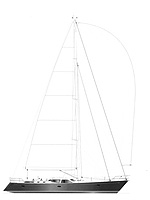Discovery 55
Family cruiserr
The drawings from Ron's office are beautiful. True, they are all computer generated, but they show the hand or finger of someone intent on producing the design as art.
The hull form is moderate with U-shaped sections forward and a small amount of deadrise aft at the transom. BWL is broad. There is a slight hint of reverse to the counter aft. There is a deep, molded-in sump in the way of the external lead keel. The keel is longish with a bulb. The rudder is hung on a half skeg with a considerable amount of balance area. Compare this to the Oyster rudder with no balance. The D/L is 246. This design shows a beautiful sheerline.
The sailplan shows an SA/D of 17.9 and you can arrange your foretriangle any way you like. All options include a self-tacking jib or staysail. Sailplan B is my favorite with an almost full-hoist, 90-degree self-tacking jib with a furling masthead genoa tacked to the stem.
In all cases the triple-spreader rig has spreaders swept to 23 degrees. The sheeting angle from the stem to the outboard edge of the self-tacking track is 10 degrees. This works on the wind, but once you bear off, it would be nice to have an additional 5 degrees to maintain a proper jib shape.
Ken Freivokh did the interior design work. If you read the megayacht magazines you will have heard of Ken's work. He's a master stylist. There are almost no surprises in this interior, a three-stateroom layout with two heads.
The galley is big and would be fun for a cook. The dinette shows rounded contours, but it also has some straight stretches. This will certainly work better than the nearly circular dinette.
Surprise! There's a pilot berth tucked under the side decks to starboard in the saloon. This is a sea berth and very unusual in this type of boat.
As usual with center-cockpit boats, the lazarette has been eroded to the point where it almost doesn't exist. The fo'c'sle is adequate but not big. Note the location of the bow thrusters. Two bow thruster options are shown. While this interior is basically normal in its components, I think it shows a heightened level of design finesse without being novel.
The deck shows narrow side decks. I like broad side decks, but in a design like this they interfere with the interior and particularly the layout of the center cockpit. This cockpit is big and, like the Oyster's, divided into two sections, although the Discovery 55 has only one wheel. One particular advantage of the narrow side decks can be seen in the room on the cabintrunk in way of the cockpit where there is sufficient space to get in hatches between the two winches. Overall deck styling is straight out of the Oyster book. It's a good-looking boat that to my eye has a little more snap and appeal than the Oyster.

Comments